 |
| Shutterstock |
Wednesday, 10 April 2024
Cosmetics and fitness exercise: the combination may not work
Sunday, 7 April 2024
9,000 to 10,000 steps a day - does it really help with health ?
 |
| Shutterstock |
Saturday, 30 March 2024
Easter 2024
 |
| Shutterstock |
Friday, 29 March 2024
Price of coffee
Think $5.50 is too much for a flat white? Actually it’s too cheap, and our world-famous cafes are paying the price
Emma Felton, University of South AustraliaEven in a stubborn cost-of-living crisis, it seems there’s one luxury most Australians won’t sacrifice – their daily cup of coffee.
Coffee sales have largely remained stable, even as financial pressures have bitten over the past few years.
So too have prices. Though many of us became upset when prices began to creep up last year, they’ve since largely settled in the range between $4.00 and $5.50 for a basic drink.
But this could soon have to change. By international standards, Australian coffee prices are low.
No one wants to pay more for essentials, least of all right now. But our independent cafes are struggling.
By not valuing coffee properly, we risk losing the internationally renowned coffee culture we’ve worked so hard to create, and the phenomenal quality of cup we enjoy.
Coffee is relatively cheap in Australia
Our recent survey of Australian capital cities found the average price of a small takeaway flat white at speciality venues is A$4.78.
But in some international capitals, it’s almost double this, even after adjusting for local purchasing power parity.
In London, a small flat white costs about A$6.96. Singapore, A$8.42. In Athens, as much as A$9.95.
The cafe business is getting harder
Over the past few decades, coffee prices haven’t kept pace with input costs. In the early 2000s, after wages, food costs, utilities and rent, many cafes earned healthy profit margins as high as 20%.
The most recent data from IBISWorld show that while Australian cafe net profits have recovered from a drop in 2020, at 7.6%, they remain much lower than the Australian average business profit margin of 13.3%.
For an independent owner operating a cafe with the average turnover of A$300,000, this would amount to a meagre A$22,800 annual net profit after all the bills are paid.
What goes into a cup?
Just looking at the cost of raw inputs – milk, beans, a cup and a lid – might make the margin seem lucrative. But they don’t paint the whole picture.
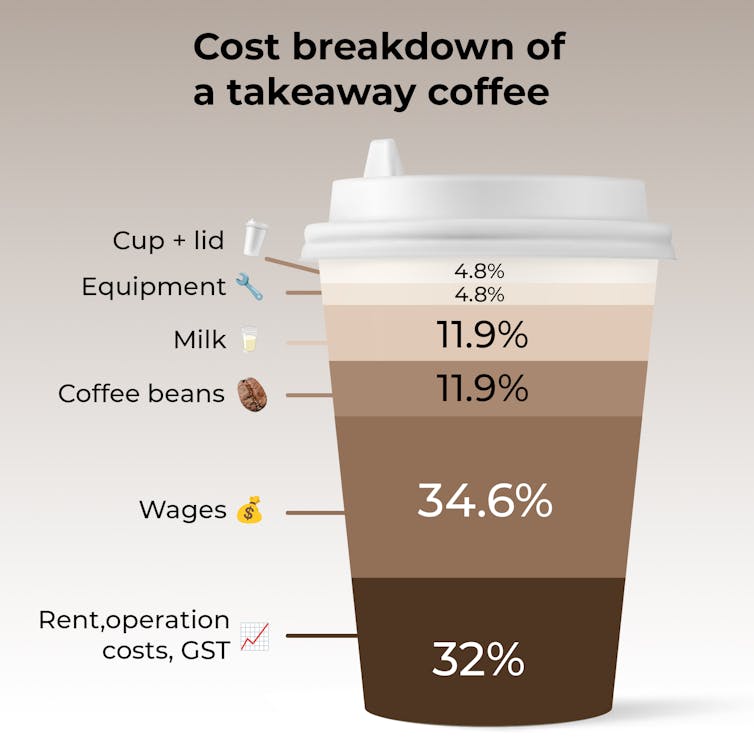
Over the past few years, renting the building, keeping the lights on and paying staff have all become much bigger factors in the equation for coffee shop owners, and many of these pressures aren’t easing.
1. Green coffee price
Increasingly subject to the effects of climate change, the baseline commodity price of green (unroasted) coffee is going up.
Arabica – the higher quality bean you’re most likely drinking at specialty cafes – is a more expensive raw product. Despite levelling off from post-pandemic highs, its price is still trending up. In 2018, it sold for US$2.93 per kilogram, which is projected to increase to US$4.38 dollars in 2025.
Robusta coffee is cheaper, and is the type typically used to make instant coffee. But serious drought in Vietnam has just pushed the price of robusta to an all-time high, putting pressure on the cost of coffee more broadly.
2. Milk prices
The price of fresh milk has risen by more than 20% over the past two years, and remains at a peak. This has put sustained cost pressure on the production of our most popular drink orders: cappuccinos and flat whites.
3. Wages and utilities
Over the past year, Australian wages have grown at their fastest rate since 2009, which is welcome news for cafe staff, but tough on operators in a sector with low margins.
Electricity prices remain elevated after significant inflation, but could begin to fall mid-year.
Specialty vs. commodity coffee: why price expectations create an industry divide
One of the key factors keeping prices low in Australia is consumer expectation.
For many people coffee is a fundamental part of everyday life, a marker of livability. Unlike wine or other alcohol, coffee is not considered a luxury or even a treat, where one might expect to pay a little more, or reduce consumption when times are economically tough. We anchor on familiar prices.
Because of this, it really hurts cafe owners to put their prices up. In touch with their customer base almost every day, they’re acutely aware of how much inflation can hurt.

But in Australia, a huge proportion of coffee companies are also passionate about creating a world-class product by only using “specialty coffee”. Ranked at least 80 on a quality scale, specialty beans cost significant more than commodity grade, but their production offers better working conditions for farmers and encourages more sustainable growing practices.
Although not commensurate with the wine industry, there are similarities. Single origin, high quality beans are often sourced from one farm and demand higher prices than commodity grade coffee, where cheaper sourced beans are often combined in a blend.
Running a specialty cafe can also mean roasting your own beans, which requires a big investment in expertise and equipment.
It’s an obvious example of doing the right thing by your suppliers and customers. But specialty cafes face much higher operating costs, and when they’re next to a commodity-grade competitor, customers are typically unwillingly to pay the difference.
Approach price rises with curiosity, not defensiveness
When cafe owners put up their prices, we often rush to accuse them of selfishness or profiteering. But they’re often just trying to survive.
Given the quality of our coffee and its global reputation, it shouldn’t surprise us if we’re soon asked to pay a little bit more for our daily brew.
If we are, we should afford the people who create one of our most important “third spaces” kindness and curiosity as to why. ![]()
Emma Felton, Adjunct Senior Researcher, University of South Australia
This article is republished from The Conversation under a Creative Commons license. Read the original article.
Tuesday, 5 March 2024
Geoengineering - cuckoo clock solutions
Not such a bright idea: cooling the Earth by reflecting sunlight back to space is a dangerous distraction

The United Nations Environment Assembly this week considered a resolution on solar radiation modification, which refers to controversial technologies intended to mask the heating effect of greenhouse gases by reflecting some sunlight back to space.
Proponents argue the technologies will limit the effects of climate change. In reality, this type of “geoengineering” risks further destabilising an already deeply disturbed climate system. What’s more, its full impacts cannot be known until after deployment.
The draft resolution initially called for the convening of an expert group to examine the benefits and risks of solar radiation modification. The motion was withdrawn on Thursday after no consensus could be reached on the controversial topic.
A notable development was a call from some Global South countries for “non-use” of solar radiation modification. We strongly support this position. Human-caused climate change is already one planetary-scale experiment too many – we don’t need another.
A risky business
In some circles, solar geoengineering is gaining prominence as a response to the climate crisis. However, research has consistently identified potential risks posed by the technologies such as:
unpredictable effects on climate and weather patterns
biodiversity loss, especially if use of the technology was halted abruptly
undermining food security by, for example, reducing light and increasing salinity on land
the infringement of human rights across generations – including, but not limited to, passing on huge risks to generations that will come after us.
Here, we discuss several examples of solar radiation modification which exemplify the threats posed by these technologies. These are also depicted in the graphic below.
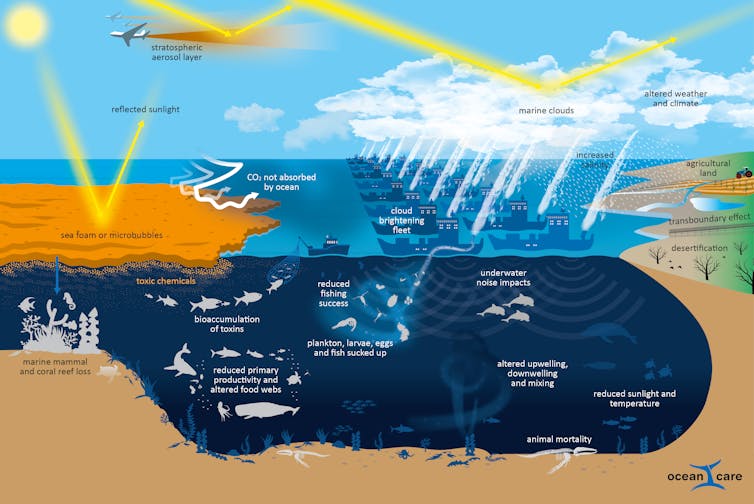
A load of hot air
In April 2022, an American startup company released two weather balloons into the air from Mexico. The experiment was conducted without approval from Mexican authorities.
The intent was to cool the atmosphere by deflecting sunlight. The resulting reduction in warming would be sold for profit as “cooling credits” to those wanting to offset greenhouse gas pollution.
Appreciably cooling the climate would, in reality, require injecting millions of metric tons of aerosols into the stratosphere, using a purpose-built fleet of high-altitude aircraft. Such an undertaking would alter global wind and rainfall patterns, leading to more drought and cyclones, exacerbating acid rainfall and slowing ozone recovery.
Once started, this stratospheric aerosol injection would need to be carried out continually for at least a century to achieve the desired cooling effect. Stopping prematurely would lead to an unprecedented rise in global temperatures far outpacing extreme climate change scenarios.
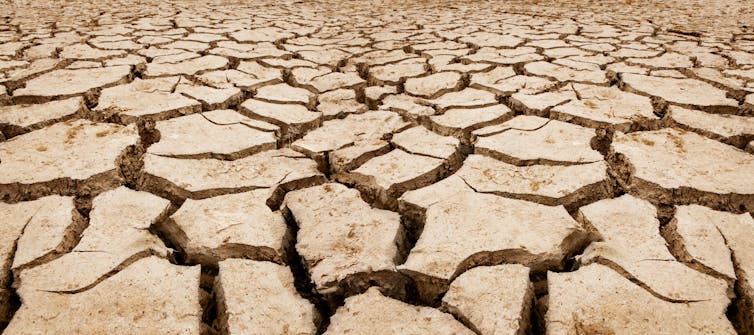
Heads in the clouds
Another solar geoengineering technology, known as marine cloud brightening, seeks to make low-lying clouds more reflective by spraying microscopic seawater droplets into the air. Since 2017, trials have been underway on the Great Barrier Reef.
The project is tiny in scale, and involves pumping seawater onto a boat and spraying it from nozzles towards the sky. The project leader says the mist-generating machine would need to be scaled up by a factor of ten, to about 3,000 nozzles, to brighten nearby clouds by 30%.
After years of trials, the project has not yet produced peer-reviewed empirical evidence that cloud brightening could reduce sea surface temperatures or protect corals from bleaching.
The Great Barrier Reef is the size of Italy. Scaling up attempts at cloud brightening would require up to 1,000 machines on boats, all pumping and spraying vast amounts of seawater for months during summer. Even if it worked, the operation is hardly, as its proponents claim, “environmentally benign”.
The technology’s effects remain unclear. For the Great Barrier Reef, less sunlight and lower temperatures could alter water movement and mixing, harming marine life. Marine life may also be killed by pumps or negatively affected by the additional noise pollution. And on land, marine cloud brightening may lead to altered rainfall patterns and increased salinity, damaging agriculture.
More broadly, 101 governments last year agreed to a statement describing marine-based geoengineering, including cloud brightening, as having “the potential for deleterious effects that are widespread, long-lasting or severe”.
Balls, bubbles and foams
The Arctic Ice Project involves spreading a layer of tiny glass spheres over large regions of sea ice to brighten its surface and halt ice loss.
Trials have been conducted on frozen lakes in North America. Scientists recently showed the spheres actually absorb some sunlight, speeding up sea-ice loss in some conditions.
Another proposed intervention is spraying the ocean with microbubbles or sea foam to make the surface more reflective. This would introduce large concentrations of chemicals to stabilise bubbles or foam at the sea surface, posing significant risk to marine life, ecosystem function and fisheries.
No more distractions
Some scientists investigating solar geoengineering discuss the need for “exit ramps” – the termination of research once a proposed intervention is deemed to be technically infeasible, too risky or socially unacceptable. We believe this point has already been reached.
Since 2022, more than 500 scientists from 61 countries have signed an open letter calling for an international non-use agreement on solar geoengineering. Aside from the types of risks discussed above, the letter said the speculative technologies detract from the urgent need to cut global emissions, and that no global governance system exists to fairly and effectively regulate their deployment.
Calls for outdoor experimentation of the technologies are misguided and detract energy and resources from what we need to do today: phase out fossil fuels and accelerate a just transition worldwide.
Climate change is the greatest challenge facing humanity, and global responses have been woefully inadequate. Humanity must not pursue dangerous distractions that do nothing to tackle the root causes of climate change, come with incalculable risk, and will likely further delay climate action.![]()
James Kerry, Adjunct Senior Research Fellow, James Cook University, Australia and Senior Marine and Climate Scientist, OceanCare, Switzerland, James Cook University; Aarti Gupta, Professor of Global Environmental Governance, Wageningen University, and Terry Hughes, Distinguished Professor, James Cook University
This article is republished from The Conversation under a Creative Commons license. Read the original article.
Monday, 26 February 2024
Russia: autocratic rule continues with the loss of Navalny
Alexei Navalny had a vision of a democratic Russia. That terrified Vladimir Putin to the core
Robert Horvath, La Trobe UniversityAlexei Navalny was a giant figure in Russian politics. No other individual rivalled the threat he posed to the Putin regime. His death in an Arctic labour camp is a blow to all those who dreamed he might emerge as the leader of a future democratic Russia.
What made Navalny so important was his decision to become an anti-corruption crusader in 2008. Using shareholder activism and his popular blog, he shone a spotlight on the corruption schemes that enabled officials to steal billions from state-run corporations.
His breakthrough came in 2011, when he proposed the strategy of voting for any party but President Vladimir Putin’s “party of crooks and thieves” in the Duma (parliament) elections. Faced with a collapse of support, the regime resorted to widespread election fraud. The result was months of pro-democracy protests.
Putin regained control through a mix of concessions and repression, but the crisis signalled Navalny’s emergence as the dominant figure in Russia’s democratic movement.
Despite being convicted on trumped-up embezzlement charges, he was allowed to run in Moscow’s mayoral elections in 2013. In a clearly unfair contest, which included police harassment and hostile media coverage, he won 27% of the vote.
Perseverance in the face of worsening attacks
The authorities learned from this mistake. Never again would Navalny be allowed to compete in elections. What the Kremlin failed to stop was his creation of a national movement around the Foundation for the Struggle Against Corruption (FBK), which he had founded in 2011 with a team of brilliant young activists.
During the ensuing decade, FBK transformed our understanding of the nature of Putin’s kleptocracy. Its open-source investigations shattered the reputations of numerous regime officials, security functionaries and regime propagandists.
One of the most important was a 2017 exposé of the network of charities that funded the palaces and yachts of then-premier Dmitry Medvedev. Viewed 46 million times on YouTube, it triggered protests across Russia.
No less significant was Navalny’s contribution to the methods of pro-democracy activism. To exploit the regime’s dependence on heavily manipulated elections, he developed a strategy called “intelligent voting”. The basic idea was to encourage people to vote for the candidates who had the best chance of defeating Putin’s United Russia party. The result was a series of setbacks for United Russia in 2019 regional elections.
One measure of Navalny’s impact was the intensifying repression directed against him. As prosecutors tried to paralyse him with a series of implausible criminal cases, they also pursued his family. His younger brother Oleg served three and a half years in a labour camp on bogus charges.
This judicial persecution was compounded by the violence of the regime’s proxies. Two months after exposing Medvedev’s corruption, Navalny was nearly blinded by a Kremlin-backed gang of vigilantes, who sprayed his face with a noxious blend of chemicals.
More serious was the deployment of a death squad from Russia’s Federal Security Service (FSB), which had kept Navalny under surveillance since 2017. The use of the nerve agent Novichok to poison Navalny during a trip to the Siberian city of Tomsk in August 2020 was clearly intended to end his challenge to Putin’s rule.
Instead it precipitated the “Navalny crisis”, a succession of events that shook the regime’s foundations. The story of Navalny’s survival – and confirmation that he had been poisoned with Novichok – focused international attention on the Putin regime’s criminality.
Any lingering doubts about state involvement in his poisoning were dispelled by Navalny’s collaboration with Bellingcat, an investigative journalism organisation, to identify the suspects and deceive one of them into revealing how they poisoned him.
The damage was magnified by Navalny’s decision to confront Putin’s personal corruption. In a powerful two-hour documentary film, A Palace for Putin, Navalny chronicled the obsessive greed that had transformed an obscure KGB officer into one of the world’s most notorious kleptocrats.
With over 129 million views on YouTube alone, the film shattered the dictator’s carefully constructed image as the incarnation of traditional virtues.
‘We will fill up the jails and police vans’
It is difficult to exaggerate the impact of the “Navalny crisis” on Putin, a dictator terrified of the prospect of popular revolution. No longer was he courted by Western leaders. US President Joe Biden began his term in office in 2021 by endorsing an interviewer’s description of Putin as a “killer”.
To contain the domestic fallout, Putin unleashed a crackdown that began with Navalny’s 2021 arrest on his return to Moscow from Germany, where had been recovering from the Novichok poisoning. On the international stage, Putin secured a summit with Biden by staging a massive deployment of military force on the Ukrainian border, a rehearsal for the following year’s invasion.
The Kremlin’s trolling factories also tried to destroy Navalny’s reputation with a smear campaign. Within weeks of Navalny’s imprisonment, Amnesty International rescinded his status as a “prisoner of conscience” on the basis of allegations about hate speech. The evidence was some ugly statements made by Navalny as an inexperienced politician in the mid-2000s, when he was trying to build an anti-Putin alliance of democrats and nationalists.
What his detractors ignored was Navalny’s own evolution into a critic of ethnonationalist prejudices. In a speech to a nationalist rally in 2011, he had challenged his listeners to empathise with people in the Muslim-majority republics of Russia’s northern Caucasus region.
This divergence from the nationalist mainstream was accentuated by Putin’s conflict with Ukraine. After the invasion of Crimea in March 2014, Navalny denounced the “imperialist annexation” as a cynical effort to distract the masses from corruption.
Eight years later, while languishing in prison, he condemned Putin’s full-scale invasion of Ukraine, exhorting his compatriots to take to the streets, saying:
If, to prevent war, we need to fill up the jails and police vans, we will fill up the jails and police vans.
Later that year, he argued a post-Putin Russia needed an end to the concentration of power in the Kremlin and the creation of a parliamentary republic as “the only way to stop the endless cycle of imperial authoritarianism”.
Navalny’s tragedy is that he never had a chance to convert the moral authority he amassed during years as a dissident into political power. Like Charles de Gaulle in France and Nelson Mandela in South Africa, he might have become a redemptive leader, leading his people from war and tyranny to the promised land of a freer society.
Instead, he has left his compatriots the example of a brave, principled and thoughtful man, who sacrificed his life for the cause of democracy and peace. That is his enduring legacy. ![]()
Robert Horvath, Senior lecturer, La Trobe University
This article is republished from The Conversation under a Creative Commons license. Read the original article.
Tuesday, 13 February 2024
The risk of ocean change and climate impact
Atlantic Ocean is headed for a tipping point − once melting glaciers shut down the Gulf Stream, we would see extreme climate change within decades, study shows

Superstorms, abrupt climate shifts and New York City frozen in ice. That’s how the blockbuster Hollywood movie “The Day After Tomorrow” depicted an abrupt shutdown of the Atlantic Ocean’s circulation and the catastrophic consequences.
While Hollywood’s vision was over the top, the 2004 movie raised a serious question: If global warming shuts down the Atlantic Meridional Overturning Circulation, which is crucial for carrying heat from the tropics to the northern latitudes, how abrupt and severe would the climate changes be?
Twenty years after the movie’s release, we know a lot more about the Atlantic Ocean’s circulation. Instruments deployed in the ocean starting in 2004 show that the Atlantic Ocean circulation has observably slowed over the past two decades, possibly to its weakest state in almost a millennium. Studies also suggest that the circulation has reached a dangerous tipping point in the past that sent it into a precipitous, unstoppable decline, and that it could hit that tipping point again as the planet warms and glaciers and ice sheets melt.
In a new study using the latest generation of Earth’s climate models, we simulated the flow of fresh water until the ocean circulation reached that tipping point.
The results showed that the circulation could fully shut down within a century of hitting the tipping point, and that it’s headed in that direction. If that happened, average temperatures would drop by several degrees in North America, parts of Asia and Europe, and people would see severe and cascading consequences around the world.
We also discovered a physics-based early warning signal that can alert the world when the Atlantic Ocean circulation is nearing its tipping point.
The ocean’s conveyor belt
Ocean currents are driven by winds, tides and water density differences.
In the Atlantic Ocean circulation, the relatively warm and salty surface water near the equator flows toward Greenland. During its journey it crosses the Caribbean Sea, loops up into the Gulf of Mexico, and then flows along the U.S. East Coast before crossing the Atlantic.
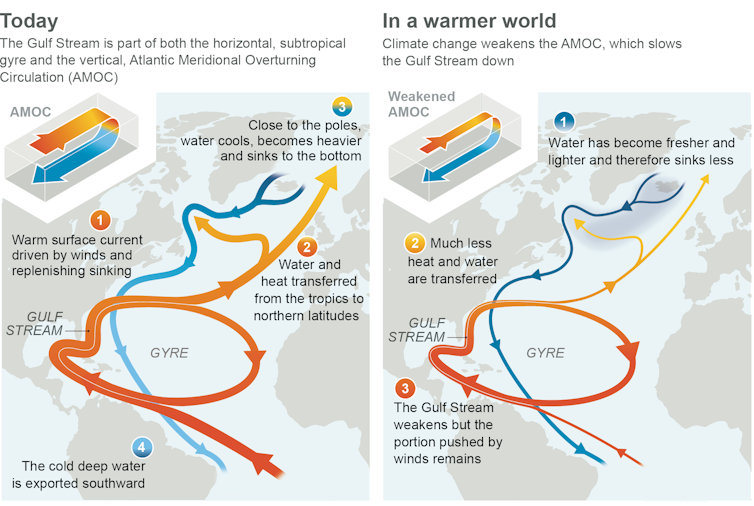
This current, also known as the Gulf Stream, brings heat to Europe. As it flows northward and cools, the water mass becomes heavier. By the time it reaches Greenland, it starts to sink and flow southward. The sinking of water near Greenland pulls water from elsewhere in the Atlantic Ocean and the cycle repeats, like a conveyor belt.
Too much fresh water from melting glaciers and the Greenland ice sheet can dilute the saltiness of the water, preventing it from sinking, and weaken this ocean conveyor belt. A weaker conveyor belt transports less heat northward and also enables less heavy water to reach Greenland, which further weakens the conveyor belt’s strength. Once it reaches the tipping point, it shuts down quickly.
What happens to the climate at the tipping point?
The existence of a tipping point was first noticed in an overly simplified model of the Atlantic Ocean circulation in the early 1960s. Today’s more detailed climate models indicate a continued slowing of the conveyor belt’s strength under climate change. However, an abrupt shutdown of the Atlantic Ocean circulation appeared to be absent in these climate models.
This is where our study comes in. We performed an experiment with a detailed climate model to find the tipping point for an abrupt shutdown by slowly increasing the input of fresh water.
We found that once it reaches the tipping point, the conveyor belt shuts down within 100 years. The heat transport toward the north is strongly reduced, leading to abrupt climate shifts.
The result: Dangerous cold in the North
Regions that are influenced by the Gulf Stream receive substantially less heat when the circulation stops. This cools the North American and European continents by a few degrees.
The European climate is much more influenced by the Gulf Stream than other regions. In our experiment, that meant parts of the continent changed at more than 5 degrees Fahrenheit (3 degrees Celsius) per decade – far faster than today’s global warming of about 0.36 F (0.2 C) per decade. We found that parts of Norway would experience temperature drops of more than 36 F (20 C). On the other hand, regions in the Southern Hemisphere would warm by a few degrees.

These temperature changes develop over about 100 years. That might seem like a long time, but on typical climate time scales, it is abrupt.
The conveyor belt shutting down would also affect sea level and precipitation patterns, which can push other ecosystems closer to their tipping points. For example, the Amazon rainforest is vulnerable to declining precipitation. If its forest ecosystem turned to grassland, the transition would release carbon to the atmosphere and result in the loss of a valuable carbon sink, further accelerating climate change.
The Atlantic circulation has slowed significantly in the distant past. During glacial periods when ice sheets that covered large parts of the planet were melting, the influx of fresh water slowed the Atlantic circulation, triggering huge climate fluctuations.
So, when will we see this tipping point?
The big question – when will the Atlantic circulation reach a tipping point – remains unanswered. Observations don’t go back far enough to provide a clear result. While a recent study suggested that the conveyor belt is rapidly approaching its tipping point, possibly within a few years, these statistical analyses made several assumptions that give rise to uncertainty.
Instead, we were able to develop a physics-based and observable early warning signal involving the salinity transport at the southern boundary of the Atlantic Ocean. Once a threshold is reached, the tipping point is likely to follow in one to four decades.
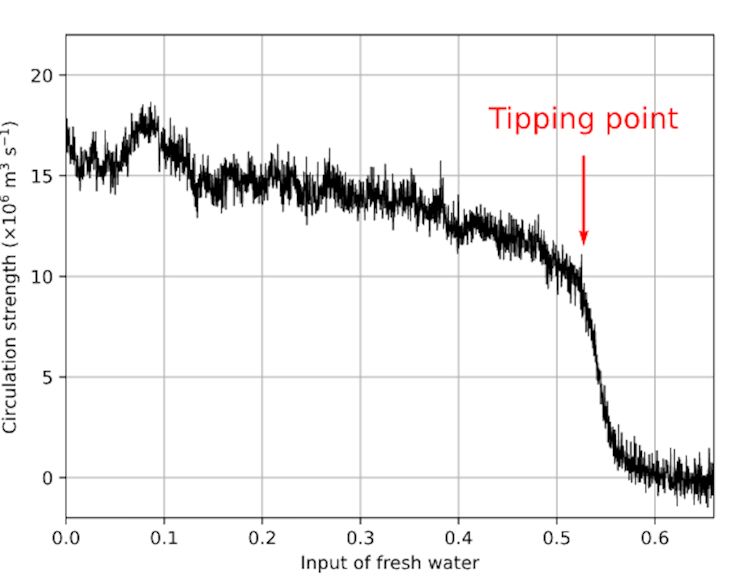
The climate impacts from our study underline the severity of such an abrupt conveyor belt collapse. The temperature, sea level and precipitation changes will severely affect society, and the climate shifts are unstoppable on human time scales.
It might seem counterintuitive to worry about extreme cold as the planet warms, but if the main Atlantic Ocean circulation shuts down from too much meltwater pouring in, that’s the risk ahead.
This article was updated on Feb. 11, 2024, to fix a typo: The experiment found temperatures in parts of Europe changed by more than 5 F per decade.![]()
René van Westen, Postdoctoral Researcher in Climate Physics, Utrecht University; Henk A. Dijkstra, Professor of Physics, Utrecht University, and Michael Kliphuis, Climate Model Specialist, Utrecht University
This article is republished from The Conversation under a Creative Commons license. Read the original article.
